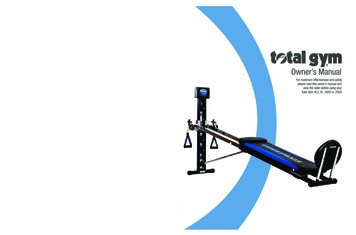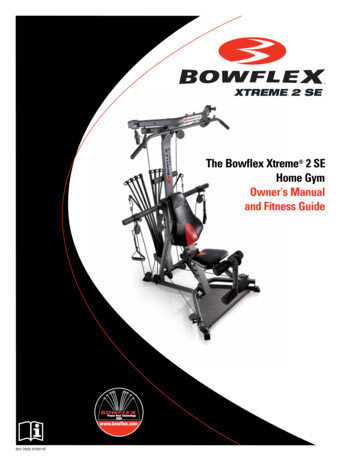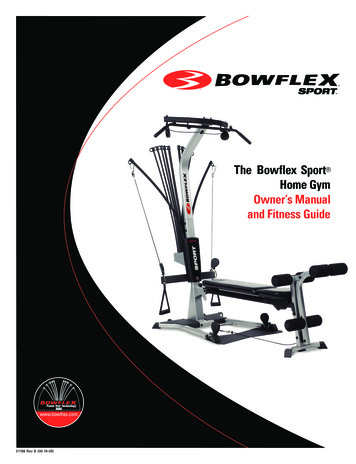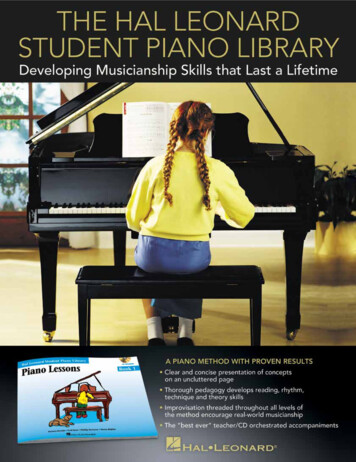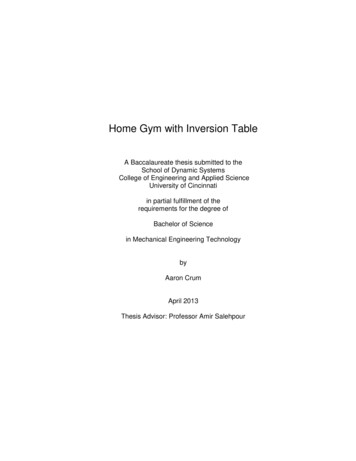
Transcription
Home Gym with Inversion TableA Baccalaureate thesis submitted to theSchool of Dynamic SystemsCollege of Engineering and Applied ScienceUniversity of Cincinnatiin partial fulfillment of therequirements for the degree ofBachelor of Sciencein Mechanical Engineering TechnologybyAaron CrumApril 2013Thesis Advisor: Professor Amir Salehpour
TABLE OF CONTENTSTABLE OF CONTENTS . IILIST OF FIGURES . IIILIST OF TABLES . IIIINTRODUCTION . 1EXISTING PRODUCTS . 2HOME GYM FITNESS EQUIPMENT .2INVERSION TABLES .4SUMMARY .5CUSTOMER FEEDBACK, FEATURES, AND OBJECTIVES . 6INTERVIEWS . 6SURVEY ANALYSIS .7FEATURES AND OBJECTIVES .8PROTOTYPE OBJECTIVES - QFD . 10SCHEDULE AND BUDGET . 11SCHEDULE . 11BUDGET . 123D SOLID MODELS OF THE TOTAL GYM . 14DRAWINGS . 14LOADING CONDITIONS AND SAFETY FACTOR . 16COMPONENT SELECTION . 20BILL OF MATERIALS . 21EXPLODED VIEW . 22FABRICATION . 23TESTING AND CONCLUSION . 32REFERENCES . 33APPENDIX A - RESEARCH. A1APPENDIX B – SURVEY . A2APPENDIX C – QUALITY FUNCTION DEPLOYMENT ANALYSIS . A3APPENDIX D – PRODUCT OBJECT IVES . A4APPENDIX E – SCHEDULE . A5APPENDIX F – BUDGET . A6APPENDIX G – SHOP DRAWINGS . A7ii
LIST OF FIGURESFigure 1 - Bowflex Home Gym . 2Figure 2 - Total Home Gym. 3Figure 3 - Teeter Fitspine Inversion Table . 4Figure 4 - IronMan LXT850 Inversion Table . 5Figure 5 – 3D Model of Machine in Workout Position . 14Figure 6 - 3D Model of Machine in Inversion Table Position . 15Figure 7 – Foot Plate Stress . 16Figure 8 – Full System Deflection . 17Figure 9 – Bending Stress in Rails. 18Figure 10 – Shear Stress of Rotational Pins. 19Figure 11 – Exploded View of Full Gym . 22Figure 12 – Waterjetting Aluminum Rotational Plates. 23Figure 13 – Band Saw Cutting . 24Figure 14 – Upholstering The Backrest . 25Figure 15 – Wheels Added onto Backrest . 26Figure 16 – Welding Steel Brackets . 26Figure 17 – Creating T-brackets . 27Figure 18 – Foot Slider Assembly . 28Figure 19 – Footrest Assembly . 28Figure 20 – Frame Coming Together. 29Figure 21 – Rotational Plate Assembly . 29Figure 22 – Machine Fully Assembled . 30LIST OF TABLESTable 1 - Survey of Important FeaturesTable 2 – QFD Analysis for Engineering CharacteristicsTable 3 – ScheduleTable 4 – BudgetTable 5 - Final Budget710111213iii
Home Gym with Inversion TableAaron CrumINTRODUCTIONHome gyms have been around for decades, with promises that just a few minutes a daycan help turn the average couch potato into the next Sylvester Stalone. They come in allshapes and sizes from the simple Bullworker spring to complex home gyms systems such asthe Bowflex.Before a workout begins, and after a workout ends, the best thing for your muscles is agood stretching. Stretching is important for people of all ages and skill levels. The benefitsinclude increasing the range of motion, reduced muscle tension, and increased circulation tovarious parts of the body. Also, stretching after working out is beneficial workout recoveryand decreases muscle soreness.One of the most useful stretching devices on the market today are inversion tables. Theseare machines that turn the user’s body upside-down, with their ankles supported by the table.The purpose of using this machine is to allow the user to stretch out after working out, andprovide a method to decompress the spine.On the market today, there are hundreds of types of home gyms, as well as inversiontables for sale. The focus of this project is to design a machine that can both incorporate ahome gym, and an inversion table into one unit.1
Home Gym with Inversion TableAaron CrumEXISTING PRODUCTSHOME GYM FITNESS EQUIPMENTThere are many different types of home gyms, but they all perform a very similar task. Theycan be broken down into two categories. One contains some type of resistance band, orspring that gives resistance to a particular motion. The other utilizes gravity as resistance,whether it is a set of weights, or the user’s own body weight.When it comes to resistance bands, the most well-known home gym is the Bowflex, asshown in Figure 1 (1). The Bowflex requires the user to overcome the bending force of theresistance bands. The different bands on the back of the machine are rated at different weightcapacities. The problems with these kind of machines are their price, as well as lack of abilityto stretch using the machine. Initial investment cost is a very key factor in purchasing a homegym, and many of these gyms can cost thousands of dollars, turning many people away.Figure 1 - Bowflex Home Gym2
Home Gym with Inversion TableAaron CrumGravity-based workout units are the predominant ones found in fitness centers. Theytypically consist of a stack of weights, a steel cable, and a few pulleys. The simplicity causesthe machines to be durable and allows the user to track their progress by seeing exactly howmuch weight they are lifting. The downsides to these machines are their high cost, and size.Other examples of gravity-based workout units include free weights such as dumbbells, andproducts that involve the user lifting a percentage of their own body weight. These machinestake up less space and are relatively inexpensive. The main complaint for these home gymsare that they lack versatility and the time it takes to adjust between workouts. An example ofone of these systems is the Total Home Gym XLS as shown in Figure 2 (2).Figure 2 - Total Home Gym3
Home Gym with Inversion TableAaron CrumINVERSION TABLESWhile many people haven’t used an inversion table, most people are familiar with themthrough TV ads, and seeing similar devices in various gyms. Almost all of them work bystrapping the user’s ankles to the lower part of the table and then flipping the user upsidedown to relax and let their muscles and spine stretch out.The most popular model on the market is the Teeter Fitspine, as shown in Figure 3 (3) isthe most popular model on the market today. It is a very basic no-frills device that allows theuser to strap their feet and ankles in and flip upside-down. As with most exercise equipment,the price always tends to be an issue. This model is over 400, while others by the samecompany can cost upwards of 900. For a device that only serves one purpose, many peoplethink the cost outweighs the benefits. Also for this particular model, there is no lockingmechanism to keep someone in place. This could be an issue causing the user to rock backand forth in the machine.Figure 3 - Teeter Fitspine Inversion Table4
Home Gym with Inversion TableAaron CrumThe IronMan LXT850 as shown in Figure 4 (4) overcomes most of the bad qualities of theTeeter device. It has a lower cost at a sub- 300 price point, and has a locking mechanism thatcan hold it into 10 different positions.Figure 4 - IronMan LXT850 Inversion TableSUMMARYThere is a gap in the market where working out, and stretching is combined into one singleunit. The goal of this project is to fill this gap with a machine that can be used to have a fullbody workout, and then quickly turn into an inversion table to stretch out with.5
Home Gym with Inversion TableAaron CrumCUSTOMER FEEDBACK, FEATURES, AND OBJECTIVESINTERVIEWSInterviews were conducted with people that have a close relationship with the world offitness and home gyms. The interviews were conducted to find out what kind of qualities areliked and disliked with home gyms and/or inversion tables.In an interview with Katy Brian, she explains how she liked and disliked her Total HomeGym (5). She explained how she has used the machine for over 5 years and has enjoyed itvery much. Also, that it was a much cheaper and more convenient solution to working outthan a gym membership.Jayme Johnson is the Coordinator of Facilities for the University of CincinnatiRecreation Center (6). As a Rec Center Coordinator, he is familiar with the hundreds ofpieces of gym equipment, and has finished his Master’s Degree in the field of ExerciseScience. He typically does not enjoy home gyms, and prefers to go to fitness centers for afew reasons. First, there is typically a larger variety of exercises that can be performed due tomany different machines. Secondly, changing from one type of workout to another is assimple as switching machines. Finally, he believes home gyms are prone to breaking, and arenot of the same quality as equipment found in fitness centers.In an interview with Christos Sampanis, he gave similar points as the previousinterviewees (7). He says that the costs of home gyms are too much and he would prefer topay a lower monthly fee rather than huge upfront costs. He also prefers fitness centers due tothe wide variety in machines. On the other hand, he also enjoys a few aspects of home gyms.These include the privacy of working out at home, as well as not having to drive somewhereto workout.6
Home Gym with Inversion TableAaron CrumSURVEY ANALYSISFourteen surveys were handed out to people within the UC Rec Center to providefeedback from people who regularly workout. The survey listed a range of product featureswith which they were to give a 1-5 rating based on their importance (1 being least important– 5 being most important). The first section of the survey was to get information on whataspects of the machine are most important to them. The second was to find out what theiropinions were on home gyms they have previously used (detailed survey results can be foundin Appendix B).The results of the survey, along with the designer improvement plan can be seen inTable 1. The average customer importance column shows the survey results. The followingcolumns show the expected improvement upon each of these qualities. The price has thesecond highest improvement ratio as this is the highest importance factor when consideringthe purchase of a home gym. This information shown is crucial in coming up with specificengineering requirements and finding ways to achieve high customer satisfaction.Table 1 - Survey of Important FeaturesQuestionsPriceCapacity for varied user height/weightEase of operationEase of assemblyQuiet operationComfortStabilitySmall footprintSafetyEase of maintenanceImportance of Features of a Home GymAvgRelativeDesigner's CurrentPlanned Improvement ModifiedCustomerWeightMultiplier Satisfaction 3.501.285.84 .165.54 04.001.005.03 .194.89 11.003.641.003.153.501.114.049.007
Home Gym with Inversion TableAaron CrumFEATURES AND OBJECTIVESThe product objectives are the same as the list of customer features. In this section, thesefeatures have been listed in order of importance, along with their relative weight percentages.Also, under each one there are a number of objectives for how the prototype of this machinecan fulfill the customer’s needs.1. Cost (13%)a. Prototype under 5002. Ease of operation (13%)a. Adjustment between exercises requires 3 stepsb. Adjusts from workout station to inversion table in 3 stepsc. Mechanisms to help with inversiond. Inversion table can be locked in all angles from horizontal to vertical with onehande. Allows user ability to work out all muscle groups without reconfiguration3. Stability (11%)a. Symmetrical designb. Consistent loading conditions and design for CG at or below comparablemachinesc. Frame to be welded instead of fastened4. Safety (11%)a. All corners covered with rubber bumpersb. Ankle supports to lock to prevent fallingc. No pinch pointsd. Safety bars on side of machine5. Capacity for varied user height/weight (9%)a. Adjustable positioning for heights between 5’0” – 6’6”b. Includes ankle supports for range of human anklesc. Material and design will be sized and selected based on a 3.0 safety factor6. Ease of maintenance (9%)a. All steels are stainless or coated to prevent rustb. All bearings are sealed requiring no lubrication7. Comfort (9%)a. Back rest is typical weight bench paddingb. Ankle supports are adjustable and padded comparable to Teeter brandc. Handle grips will be ergonomic8
Home Gym with Inversion TableAaron Crum8. Ease of assembly (8%)a. Uses standard hardwareb. Uses standard tools for assembly and teardownc. Unit has 10 parts that need assembling9. Small footprint (8%)a. Product to take up no more than 6’x4’ floor spaceb. Foldable frame to take up no more than 3’x4’ floor space10. Quiet operation (7%)a. Contains roller bearings for smooth movementsb. Uses rubber feet to prevent floor noise and vibration9
Home Gym with Inversion TableAaron CrumPROTOTYPE OBJECTIVES - QFDThe analysis in Table 2 shows how the engineering characteristics given at the top of thechart are going to be solutions to the customer requirements in the left-hand side of the chart.These have been weighted and compared to achieve a relative weight percentage that willdictate which of these engineering characteristics are the most important to the final design.Comfort9Ease of Maintenance4.14 1.10 2.73 3.50 1.28 5.84 0.1313%4.36 1.10 3.46 4.00 1.16 5.54 0.1313%4.57 1.10 4.00 4.00 1.00 5.03 0.1111%34.10 1.00 3.77 4.50 1.19 4.89 0.1111%93.43 1.10 3.38 3.50 1.04 3.91 0.099%3.64 1.00 3.15 3.50 1.11 4.04 0.099%3.71 1.00 3.23 3.50 1.08 4.02 0.099%92.92 1.00 3.17 4.00 1.26 3.68 0.088%33.43 1.00 2.80 3.00 1.07 3.68 0.088%2.92 1.00 3.69 4.00 1.08 3.17 0.077%911993191939Small footprintEase of assembly9Quiet operation9199Abs. importance3.162.382.05 1.79 1.72 1.69 1.52 1.28 1.27 1.03Rel. importance0.180.130.11 0.10 0.10 0.09 0.09 0.07 0.07 0.06Rel. importance %18%13% 11% 10% 10% 9%Modified ImportanceRelative weight %9Improvement ratio1Planned Satisfaction1Current Satisfaction3Designer's Multiplier1Customer importanceBack rest1Symmetrical DesignRoller Bearings13SafetyCapacity for varied height/weight9Relative weightStability9Foldable frame1Handles3Ease of OperationStandard tools used for assemblyPriceRubber corners and feetAnkle supports9 Strong3 Moderate1 WeakCoated or stainless steelAaron CrumHome Gym withInversion TableStandard hardwareTable 2 – QFD Analysis for Engineering Characteristics9% 7% 7%6%17.937.0 0.84 0.841.0100%The left side of this table shows the customer features. The top and center of the tableshows how engineering characteristics relate to these features. To the right of the body, wehave importance weights to each feature determined by taking the average responses fromthe surveys. Also, there is a designer’s multiplier and a final relative weight percentage.Finally, we have a relative importance percentage at the very bottom row that shows whichcharacteristics are most important to implement in the design.10
Home Gym with Inversion TableAaron CrumSCHEDULE AND BUDGETSCHEDULEThe project time-table can be seen in Table 3. The concept development marks the beginningof the design phase of this project beginning in October. The design phase continues up tillthe end of December. Upon the start of spring semester, the fabrication phase will begin. Thiswill run up till through March, with another month of tweaking and customer testing.Table 3 – Schedule11
Home Gym with Inversion TableAaron CrumBUDGETAn initial budget of expenses is included inTable 4. This does not take into account machining and tooling costs. Prices based oninternet quotes as of October 18, 2012.Table 4 – BudgetBudgetFrame40’ Tube steel ( 2/ft.)10’ Channel steel ( 2.1/ft.) 80 21Rolling BackrestBearingsWheelsSheet of plywoodShoulder bolts ( 2.5/ea.)Vinyl sheeting ( 11/yd 2)Foam padding 13 19 11 10 22 25Inversion Table Pivot Joint and HandlesBar steel ( 2.90/ft.)Tube steel ( 2/ft.) 3 8Resistance SystemHandlesResistance band setPulleys ( 11/ea.)Steel cable ( 1/ft.) 13 20 22 10Subtotal 27720% Miscellaneous expenses 55Total 33312
Home Gym with Inversion TableAaron CrumTable 5 - Final BudgetFinal BudgetFrame2" Square tubing 1302.5" Square tubing 752"x2" Angle Steel 30Aluminum Sheet 25Steel Rod 5Rolling BackrestTrucks/Wheel AssemblyWoodVinyl SheetingFoam Padding 40 25 20 8Resistance SystemHandlesPulleysSteel CableCable ClampsCarabinersFoam Padding 20 30 12 4 15 20HardwareNuts, Bolts, Washers, ClipsCasters and Feet 15 30Total 504The cost ran over the planned budget. There were parts that were unanticipated, andthe cost of the metals changed based off the vendor used. These parts were purchased basedon what could be readily found, thus altering the original design slightly and increasingoverall costs.13
Home Gym with Inversion TableAaron Crum3D SOLID MODELS OF THE TOTAL GYMDRAWINGSA full 3D model was created to see ensure all pieces will fit together properly. Therendering below in Figure 5 shows the machine as it is setup for working out. This positionallows the user to work out against their own body weight by laying on the backrest andpulling themselves upwards (pulley cables and handles not shown).Figure 5 – 3D Model of Machine in Workout Position14
Home Gym with Inversion TableAaron CrumThe rendering below in Figure 5 shows the machine as it is setup for use as an inversiontable. This position allows the user to be suspended upside down by their ankles. Due to alocking mechanism, they can stay in this position until they are ready to rotate back tostanding position.Figure 6 - 3D Model of Machine in Inversion Table Position15
Home Gym with Inversion TableAaron CrumLOADING CONDITIONS AND SAFETY FACTORMost of the stress that this machine will see comes from the weight of the user indifferent positions. Points of high-stress have been analyzed to ensure there will not befailure. Since this machine will be holding a human above the ground, it is critical to ensurethis machine will not fail and cause serious injury to the user. A maximum weight limit hasbeen set at 300lbs, with a safety factor of two when calculating stresses. The following FEAcalculations have shown that with 600lbs of force loading on critical points, there should beno mechanical issues.When stepping onto the machine to prepare for inversion, it is likely that the user willstep on one side of the foot plate bar with their entire weight. Figure 7 shows the stressincurred in this subassembly if the user steps on the far edge. The force given for thiscalculation is 600lbs, which equates to 36kpsi of stress on the joint edge. Because of a90kpsi yield strength, this gives a total safety factor greater than 4.Figure 7 – Foot Plate Stress16
Home Gym with Inversion TableAaron CrumThe same force has been applied in Figure 8 to check for deflection other parts of thesystem. This shows that most of the deflection will occur within the foot plate area. While thedeflection is as important as the stress on the parts, it is important to include it because toomuch deflection will cause the user to think the machine is cheaply made.Figure 8 – Full System Deflection17
Home Gym with Inversion TableAaron CrumAnother stress to be considered was the bending force occurred on the rails due to theuser laying on the backrest. This is shown below in Figure 9. In this calculation, it has beenassumed the four wheels will be in contact with the longest portion of channel aluminum fora worst case scenario and a 2.5 safety factor. This yields just under 5000 psi bending stress.This is significantly under the bending yield stress.Figure 9 – Bending Stress in Rails18
Home Gym with Inversion TableAaron CrumFinally, hand calculations have been done to show that a ½” steel bolt should besufficient to support the shear stresses in the rotational joints. As shown in Figure 10, the pinwill have a shear stress under 2300psi with 450 lbs of load. This is significantly under the18000psi shear stress yield mark for 304 stainless steel.Figure 10 – Shear Stress of Rotational Pins19
Home Gym with Inversion TableAaron CrumCOMPONENT SELECTIONFor the majority of this project, standard parts have been chosen to cut costs and easeprocurement. Only a few parts, including casters, spring pins, and backrest rolling assemblyare parts that need to be purchased and cannot be created from stock materials in the machineshop. All joints are designed to be fastened with standard bolt sizes that are readily availableat any hardware store.The rails were originally chosen to be aluminum, but after a trial, this showed to be toomalleable. Steel was then chosen. It turned out very well in terms of rigidity, and the abilityto weld brackets onto it.Almost the entire rest of the assembly is composed of 2” square tube steel. It will havemore than enough strength to support any kind of stresses this machine will incur. Secondly,it is readily available at many steel warehouse locations. Finally, this steel is easilymachined, and weldable.20
Home Gym with Inversion TableAaron CrumBILL OF MATERIALSBill of MaterialsQuantity dor2" Square Tube2" Channel20" x 20" x 1/4" Plate1/2" Dia. Rod2.5" Square Tube3/16” Steel Wire3" Dia Tube48" x 20" x 3/4"100" x 20" SheetingCastersAdjustable Height FeetPulleysSpring PinLongboard Wheel AssyNylon Strap Handles1/2" Dia Pins With nyl-Metals DepotMetals DepotMetals DepotMetals DepotMetals DepotHome DepotAmazon.comHome DepotWalmartMcMaster CarrMcMaster CarrGraingerJ.W.Winco Inc.Amazon.comAmazon.comNational Gym Supply Inc.21
Home Gym with Inversion TableAaron CrumEXPLODED VIEWThe following drawing shows the parts and assemblies in an exploded view. Alsoincluded is a list of part and assembly names that correspond with the bill of materials.Figure 11 – Exploded View of Full Gym22
Home Gym with Inversion TableAaron CrumFABRICATIONAfter acquiring metals, and placing orders online through vendors such as McMasterCarr, and Grainger, the construction phase was started. The first pieces, the rotational plateswere done at work with the use of a waterjet machine. The precision and tolerances needed tobe CNC cut.Figure 12 – Waterjetting Aluminum Rotational Plates23
Home Gym with Inversion TableAaron CrumThe band-saw was used to cut the tube steel down to size, as well as to put 45 degree angleson pieces.Figure 13 – Band Saw Cutting24
Home Gym with Inversion TableAaron CrumHere, after cutting the wood to size, the vinyl sheeting is being wrapped and stapled intothe wood. Also, polyfil was stuffed inside to create a comfortable seat.Figure 14 – Upholstering The Backrest25
Home Gym with Inversion TableAaron CrumFinally, longboard trucks and wheels were attached to the backrest to have a finishedproduct. The truck assemblies came with the wheels and bearings, so this process was fairlyeasy.Figure 15 – Wheels Added onto BackrestIn the shop, pieces were getting welded together to later form the other assemblies.Figure 16 – Welding Steel Brackets26
Home Gym with Inversion TableAaron CrumThese two T-joints were created for supporting the vertical posts. They were welded outof 2.5” square tube steel with a webbing thickness that allowed 2.0” steel to slide througheasily.Figure 17 – Creating T-brackets27
Home Gym with Inversion TableAaron CrumThis piece is part of the footrest assembly that will allow for change in leg thickness ofthe user. The pin will hold this slider in place. The following picture shows it on the footrestassembly.Figure 18 – Foot Slider AssemblyFigure 19 – Footrest Assembly28
Home Gym with Inversion TableAaron CrumThe following photo shows how all the bandsaw cuts are coming together to put theframe intact.Figure 20 – Frame Coming TogetherThe rotational place assembly was then bolted on, causing two different parts to be ableto rotate independantly of one-another.Figure 21 – Rotational Plate Assembly29
Home Gym with Inversion TableAaron CrumAfter cutting the foam for the footrest assembly, and adding cables, pulleys, and otherhardware, the workout part of the machine is finished.Figure 22 – Machine Fully Assembled30
Home Gym with Inversion TableAaron CrumThe final photo here shows the machine in an inverted position, although not fully 90degrees vertical. This was just to show that the backrest was held in place, and that there wasno issues with the machine in terms of usability.31
Home Gym with Inversion TableAaron CrumTESTING AND CONCLUSIONThe machine was tested under real-world conditions. Different people tried out themachine to check for any issues with the system. While the machine could be used asprojected, there were parts that were difficult to use.The first issue was the rotational plates. While good on paper, these plates were verydifficult to use in the real world. The issue here was that the pin th
One contains some type of resistance band, or spring that gives resistance to a particular motion. The other utilizes gravity as resistance, whether it is a set of weights, or the user's own body weight. When it comes to resistance bands, the most well-known home gym is the Bowflex, as shown in Figure 1 (1). The Bowflex requires the user to .

